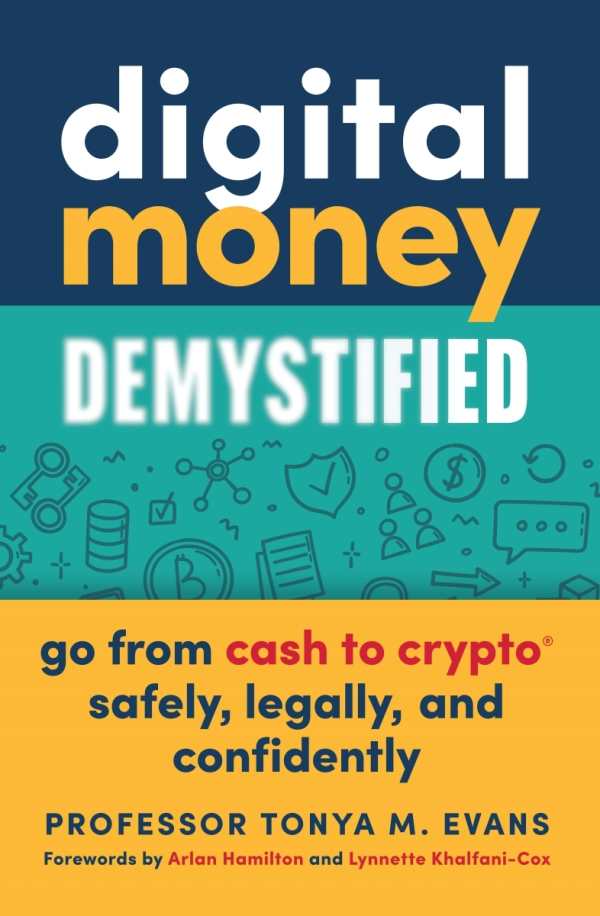Digital Money Demystified
Go From Cash to Crypto Safely, Legally, and Confidently
Digital Money Demystified is a field-leveling, enjoyable introduction into a forbidding but ever more relevant financial topic.
Pennsylvania State University professor, digital asset consultant, and CEO Tonya M. Evans’s myth-busting cryptocurrency primer, Digital Money Demystified, is designed to give beginners the skills and educational edge to navigate the evolving field of digital currency with security and confidence.
Stepping into the whirlwind of opinions on cryptocurrency, Digital Money Demystified is a field-leveling textbook that, in Evans’s words, “aims to compress your learning curve and equip you with the facts you need to maneuver the volatile crypto economy.” Conscious of the information imbalance that dissuades interested audiences from engaging in cryptocurrency, the book also places special attention on the unique characteristics that inform how individuals make financial decisions. It includes bite-sized digressions on economic history, practical worksheets, and a forthright discussion of the risks and potential gains involved in cryptocurrency. The result is an enjoyable introduction to a forbidding topic.
Every chapter revolves around a commonly held myth regarding digital money, ranging from “Crypto is just one big scam” to “Crypto is unregulated.” Each myth is confronted via academic research and real-life examples that run counter to unfounded beliefs. Concerning the regulation of cryptocurrency, for example, Evans writes that “the perception that cryptocurrency is completely unregulated is pervasive, but false”; she outlines the laws that digital money is subject to and breaks down the criminal case against “crypto golden boy” Sam Bankman-Fried. This chapter makes clear that crimes involving cryptocurrency are not unique to cryptocurrency; indeed, they are the same financial schemes and frauds perpetrated in traditional banking systems.
Evans’s expertise and deep engagement with the subject of digital money is apparent throughout. She uses personal anecdotes to illustrate the successes and pitfalls that she faced in the process of becoming a leading expert in the field. Her erudition is also evident in the book’s digestible sections, which place a premium on comprehension and accessibility. Among the most valuable elements of the book is its comprehensive glossary of acronyms and jargon—terms that are all but inescapable in the field of cryptocurrency. When paired with the text’s self-aware employment of technical terminology, this glossary is a considerable resource for those hoping to become fluent in the methods and innovations of evolving monetary systems.
Still, the book displays some intermittent bias toward digital money that interrupts its otherwise refreshing neutrality, infusing its analyses of cold facts with marketing-style jargon. In busting the myth around cryptocurrency’s destructive environmental impact, for example, the book elides the severity of cryptomining’s carbon output by shifting focus onto the environmental impact of other industries and emphasizing the possibility of “potential environmental benefits” stemming from the blockchain. A similar pattern emerges in other chapters: from providing and contextualizing research-based facts, they are prone to shifts toward interrogating the abstract FUDs (fear, uncertainty, and doubt) individuals hold regarding digital money. This intervention into presumed outside mindsets represents a distinctive break from the book’s otherwise sober advice to act within one’s financial comfort zone.
Still, Digital Money Demystified is an empowering guide to making informed choices about cryptocurrency and digital assets.
Reviewed by
Willem Marx
Disclosure: This article is not an endorsement, but a review. The publisher of this book provided free copies of the book and paid a small fee to have their book reviewed by a professional reviewer. Foreword Reviews and Clarion Reviews make no guarantee that the publisher will receive a positive review. Foreword Magazine, Inc. is disclosing this in accordance with the Federal Trade Commission’s 16 CFR, Part 255.

